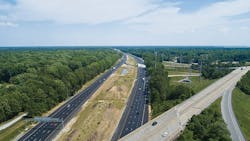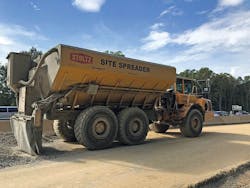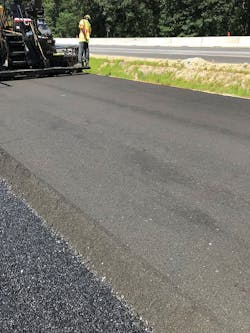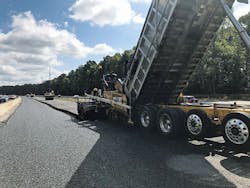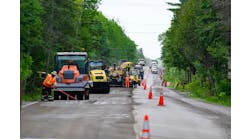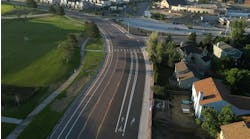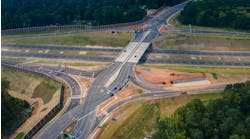Travelers along I-64 between Newport News and Williamsburg may be headed for several attractions in the coastal region of Virginia.
This includes Colonial Williamsburg, the largest living history museum in the U.S., as well as two of the largest theme parks on the East Coast—Busch Gardens and Water Country USA.
These attractions, in addition to a particularly large concentration of military bases in the area, have created the conditions for a rather congested I-64, which previously only carried four lanes of traffic. The Virginia DOT (VDOT) saw fit to widen the interstate to a total of six lanes, adding a 12-ft lane in each direction and a 12-ft shoulder. This work is part of the department’s overall effort to improve mobility on the Virginia Peninsula through the I-64 Widening Project.
The second segment of the I-64 widening is located in the City of Newport News, James City County, and York County. The work widened I-64 from 1.05 miles west of Route 199 (Humelsine Parkway / Marquis Center Parkway) near exit 242 to where the Segment I project ends at 0.54 miles east of Route 238 (Yorktown Road) near exit 247. This extends the three-lane section of I-64 from the point where the I-64 Segment I project ends west for approximately 7.08 miles.
“The main reason for the project is the 7-mile section of roadway, roughly from Williamsburg to Newport News area,” Ben Bushey, senior project manager for contractor Allan Myers, told Roads & Bridges. “It is a very congested area, and the widening of three lanes just alleviates a lot of the congestion. And it was done to reduce the amount of traffic that was coming through—giving them three lanes instead of two. The reason for the widening, pavement reconstruction, and new asphalt was the old pavement was not up to snuff and they needed more capacity, so they widened it.”
Aside from the additional 12-ft travel lanes and 12-ft shoulders, the improvements in Segment 2 included pavement reconstruction of the existing lanes and widening of nine existing bridges and six box culverts that lie inside the project limits.
The goal of these improvements is to increase capacity, bring portions of the interstate up to current design standards, provide more lanes for evacuation, improve safety by reducing congestion, and improve vehicular level of service, according to VDOT.
CHALLENGING WORK
For Segment 2 of the I-64 Widening Project, the widening occurred primarily in the median of the existing interstate, limiting the amount of right of way required to construct the project and avoid impacts to existing interchanges. Work for Allan Myers began in October 2016.
According to Bushey, the first piece of work completed was widening the road from two lanes to three—adding a 12-ft lane and 12-ft shoulder to the inside of the eastbound and westbound direction. “In the first phase, in order to work that area effectively, we had to push traffic to the outside. So we performed shoulder strengthening in the first phase to get traffic pushed to the outside via some temporary pavement, installed barriers, and then essentially constructed the left lane and the left shoulder in both directions, widened it, and then once it was fully completed, essentially took traffic to phase 2,” Bushey said. “Then we put them on the other side of the barrier on the inside of the newly constructed lanes, removed the existing pavement on the existing lanes, reclaimed the area and treated the area, constructed any pavement layers that are required, and then opened traffic to the full configuration.”
According to the contractor, the project was particularly challenging due to the various attractions along the corridor—which meant interacting with a tremendous amount of on- and off-ramps, making maintenance of traffic (MOT) an especially arduous task. “Basically we had to maintain two lanes of traffic in each direction once the project started,” Craig Rayfield, Quality Control Manager for paving for Allan Myers, told Roads & Bridges. “So all your closures were nightly, and there was a lot of night work that took place.”
A “GREEN” PROJECT
One of the unique elements of this project was the use of recycled materials. Segment 2 included both full-depth reclamation (FDR) and cold central plant recycling (CCPR).
The contractor said that VDOT included a spec for CCPR to take the material “to the next level.” On top of that, a plethora of reclaimed asphalt paving (RAP) materials were available throughout the state, including piles from Allan Myers.
“This was probably the largest recycling project that VDOT had undertaken at this time to use the FDR, the recycled concrete, and the CCPR material,” Rayfield said. “One of the previous jobs it was used on was the 81 corridor about 14 years ago. VDOT liked the success of it, so one of the options on this contract was the CCPR material. We chose it because in our minds we thought it was going to be a new technology. VDOT was going to try to push this technology toward the future, and we wanted to be on the cutting edge of it. So we jumped in feet first.”
Rayfield said one of the challenges with the FDR work was getting the prep work done. “I think the FDR had over 85+ designs that had to be tested and the formulas put together. We spent weeks out there setting closures and doing bore holes—I think it was one boring every 25 linear ft so the designs could be approved and meet the VDOT specifications with the material in place or had to have material added.” Once that was done and construction began, Rayfield said the challenge was making sure those mix designs were followed, for the team to know where they were throughout the project, and to know which design to use.
The project also saw challenges with the installation of CCPR, which is a cold mix material that was 85% RAP millings in the mix. The contractor was tasked with developing the mix design and testing it at the Allan Myers facility to make sure it would work. “No one’s ever used it on a job of this scale, so we were kind of the guinea pigs figuring out how to make it, how to use it successfully, what are the pros and cons, dealing with temperatures, how do we test it accurately to get the results we want,” Bushey explained. “Essentially, you wanted to use 85% RAP because there’s all these piles of asphalt millings throughout the state, and they wanted to be able to utilize some of them in their roads. We really didn’t have any ‘base layer’ of asphalt—it consisted of CCPR. So it was a very big challenge in terms of special equipment that had to be brought in to make the materials.”
The details of the asphalt mix laid down on this project included:
- 12 in. FDR—350,000 SY / 150,000 tons of cement-treated recycled crushed concrete
- OGDL (Open Graded Drainage Layer): 2 in. installed—19.0 mm using PG 64E-22
- Cold Central Plant Recycle Material: 6 in. installed—25.0 mm using Foamed PG 64-22 and portland Cement – 190,000 tons
- SMA-19.0 (Stone Matrix Asphalt): 2 in. installed—19.0 mm using PG 64E-22 – 15% RAP
- SMA-12.5 (Stone Matric Asphalt) 2 in. installed—12.5 mm using PG 64E-22 – 15% RAP
- IM-19.0(A): 2 in. installed—19.0 mm using PG 64S-22 – 30% RAP
- SM-12.5(D): 2 in. installed—12.5 mm using PG 64S-22 – 30% RAP
The project also included laying down 220,000 tons of hot mix asphalt. Allan Myers said IRI was achieved on the pavement based on VDOT specifications, with an eastbound three-lane average of 50.81 and a westbound three-lane average of 55.19.
The equipment used for the FDR portion of the project included Wirtgen WR 250 Series Recyclers and soil stabilizers; Hamm H20I Compactor w/vibratory smooth drum roller (22-ton); Hamm H20I Compactor with padfoot drum and blade (22-ton); and a Volvo A30 Articulated Dump with a Stoltz 20-ton fully automated spreader box. For the CCPR part of the project, equipment included a Cat 1055 paver; Cat CB13 (12-ton roller); and a Cat CB15 (15-ton roller). Asphalt material placement equipment included Weiler MTV (E2850B, E1650A and E1250B); Cat 1055 & 655 pavers; Cat CB8 (8-ton roller); Cat CB13 (12-ton roller); and Cat CB15 (15-ton roller).
The scope of recycling work undertaken by Allan Myers earned this project a 2021 Roads & Bridges / ARRA Recycling Award.
In April 2019, all three travel lanes in each direction along Segment 2 of the I-64 Widening Project were completed and opened to traffic.
